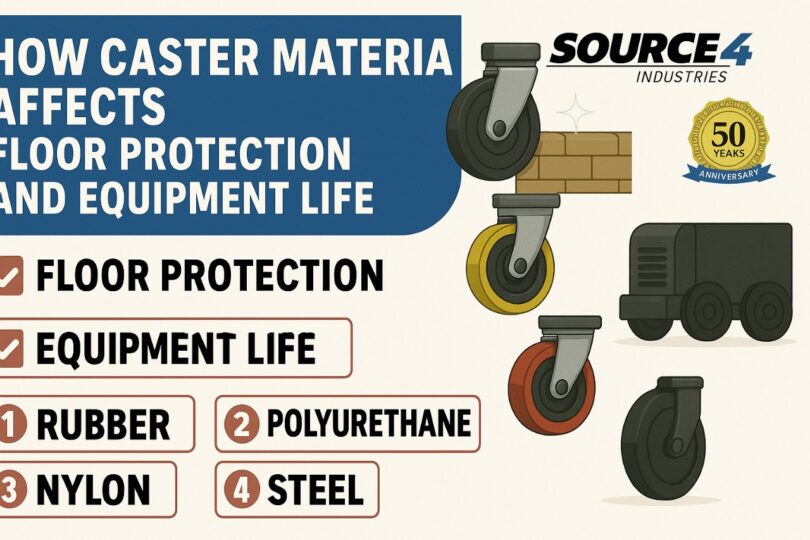Industrial, commercial, and institutional spaces often house equipment that goes unnoticed. One of these equipment is casters. Casters are tiny but essential parts that have a direct impact on floor protection, equipment life, and general safety. The choice of caster material is not just a matter of taste; it’s an informed decision that makes a difference in long-term operational effectiveness. This blog will discuss why selecting the right caster material is important.
What Are Casters and What Do They Do
Casters are wheel mounts placed on the underside of equipment, furniture, or carts to provide simple mobility. Casters play a key role in minimising labour and maximising mobility across commercial and industrial spaces. But not all casters are the same. The material of caster wheels can impact the manner they handle flooring surfaces and how they behave over the lifespan of the equipment they’re mounted on.
The Relationship Between Caster Material and Floor Protection
Floor damage is one of the main concerns with selecting heavy-duty casters. Floors are a significant investment, and the improper caster can scuff, crack, or otherwise wear away flooring surfaces over time.
Hard Casters: Nylon, steel, or cast iron are tough and ideal for harsh or abrasive surfaces. Unfortunately, they tend to damage softer floor surfaces such as hardwood, tile, or epoxy coatings. Hard casters have a tendency to focus forces onto small areas of the surface, which makes them likely to scratch or dent floors.
Soft Casters: Rubber, polyurethane, and thermoplastic elastomers are more forgiving. They roll more evenly, are quieter, and are much kinder to sensitive floor surfaces. These materials cushion, which not only cushions floors but also reduces vibrations to equipment.
For polished concrete, hardwood, or vinyl flooring facilities, soft casters are usually preferred to preserve surface integrity and appearance.
How Caster Material Affects Equipment Life
In addition to floor protection, the materials used in casters also directly affect the wear and tear of the equipment that is mobilized. Vibration and shock resulting from hard wheels can be transmitted into carts’ or machinery chassis, resulting in structural fatigue in the long term. This shortens the life of the equipment as well as raises the cost of maintenance.
Soft casters soak up some of these shocks and dissipate vibration. This is particularly significant in sensitive or precision equipment, like medical carts or laboratory benches, where stability is paramount.
Also, the choice of caster influences maneuverability. Soft materials tend to have greater traction and control, resulting in smoother operation and less operator fatigue, which indirectly contributes to the life of the equipment.
Environmental Factors to Consider
The operating conditions are the key to choosing the proper caster material. For example:
Wet or oily floors: Rubber and polyurethane casters roll well without slipping.
Extreme temperatures: Metal casters and high-temperature polymers endure higher temperatures without breaking down.
Heavy use: Cast iron or forged steel casters might be necessary, but floor damage can be minimized by using protective coatings or floor mats.
In heavy-traffic areas where guard rail systems have been installed to guide flow and safeguard structural components, equating caster material to the floor and traffic volume guarantees safety and effectiveness. Ineffective caster material can cause accidents, increased maintenance, and downtime.
Matching Casters to Cart Use
When selecting casters for carts, one must take into account their load-bearing capacity and usage frequency. A warehouse cart with the ability to transport hundreds of pounds across concrete will require a different caster than a hospitality cart running on carpeted surfaces. For industrial applications, dual-wheel polyurethane casters may best achieve a balance between load and floor maintenance. For light-duty uses, rubber casters may offer adequate protection and mobility.
Final Thoughts
Your casters’ material must never be an afterthought. It has a direct bearing on floor maintenance expense, equipment longevity, operating noise levels, and safety. By making deliberate choices between surface type, load requirements, environmental conditions, and usage frequency, you can make educated decisions that optimize efficiency and minimize long-term cost.
Whether equipping a fleet of facility carts or choosing parts for a machinery rebuild, purchasing the correct caster material helps you guard your floors, save your equipment, and ensure smoother operations, all with feet firmly on the ground.







